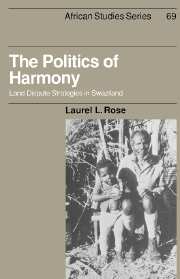Book contents
- Frontmatter
- Contents
- List of figures, tables and maps
- List of cases
- Acknowledgements
- Glossary
- Introduction
- PART I NATIONAL AND LOCAL SETTINGS
- 1 Geographical, historical, political and social bases of customary land tenure relations
- 2 The legal structure for customary land tenure relations
- 3 Two communities: arenas for land disputes
- PART II HARMONY AND LAND
- Appendix
- Notes
- References
- Index
- Other books in the series
2 - The legal structure for customary land tenure relations
from PART I - NATIONAL AND LOCAL SETTINGS
Published online by Cambridge University Press: 01 October 2009
- Frontmatter
- Contents
- List of figures, tables and maps
- List of cases
- Acknowledgements
- Glossary
- Introduction
- PART I NATIONAL AND LOCAL SETTINGS
- 1 Geographical, historical, political and social bases of customary land tenure relations
- 2 The legal structure for customary land tenure relations
- 3 Two communities: arenas for land disputes
- PART II HARMONY AND LAND
- Appendix
- Notes
- References
- Index
- Other books in the series
Summary
This chapter discusses Swaziland's history of land legislation, Southern African land law developments and Swaziland's dual system of land law. On the one side of Swaziland's dual legal structure are ‘traditional’ courts, in which procedures are not controlled by legislative enactments or by codified legal rules. These courts include family and Chiefs' ‘Courts’ (councils) at the lowest level. On the other side of Swaziland's dual legal structure are ‘modern’ courts, or the colonial/post-colonial system of courts which have been formalized by national legislation. These courts consist of both Swazi and European-influenced courts at lower levels. As will be explained, customary land matters cannot be processed by either the Swazi Courts or Subordinate Courts, so that land matters that are not successfully resolved through private negotiation or settled by chiefs' councils must be either appealed to higher levels in the customary system or handled by one of the modern administrative agents, for example Ndabazabantu. At the same time, decisions in the Swazi or Subordinate Courts regarding matters related to land can influence disputants' opportunities in customary land cases. Disputing forums and authorities in each system influence the production of harmony.
Legislative history of Swaziland's dual legal system: the basis of a parallel system of land law
A convenient starting-point for discussion of Swaziland's dual legal system is 1894 when Swaziland became the centre of negotiation between European powers.
- Type
- Chapter
- Information
- The Politics of HarmonyLand Dispute Strategies in Swaziland, pp. 36 - 57Publisher: Cambridge University PressPrint publication year: 1992



